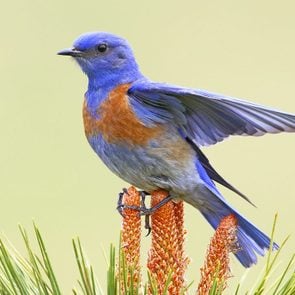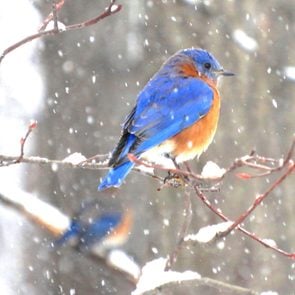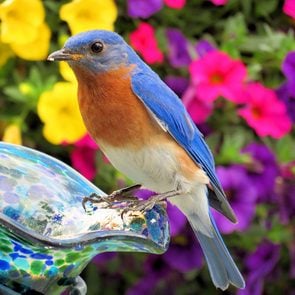How to Make a DIY Bluebird House
Updated: Jan. 25, 2024
Want to attract bluebirds to nest in your yard? Make a bluebird box! These DIY bluebird house plans meet the birds' nesting requirements.
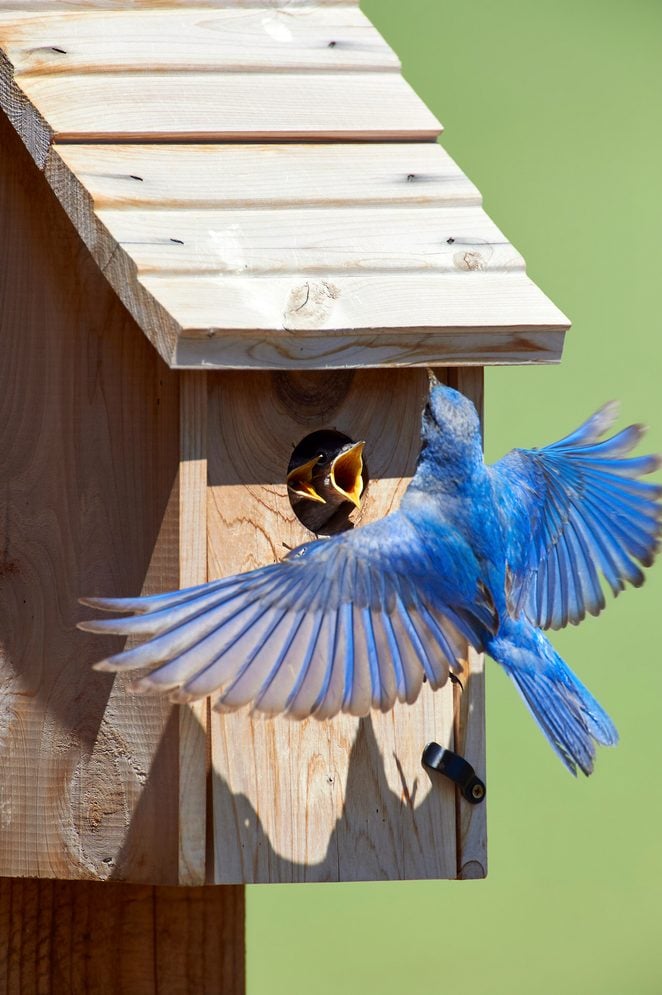
Want to do something that’s good for bluebirds—and fun for you? Learn how to build a DIY bluebird house! You’ll be charmed by the brilliant birds’ beauty and their cheerful singing… not to mention adorable baby bluebirds. Since their diet consists primarily of insects and grubs, your garden may benefit, too.
Check out our guide to feeding mealworms to birds.
In the past, bluebirds relied on woodpeckers and other cavity-dwellers to provide the majority of their nesting places. They’d select abandoned cavities in dead trees or rotten fence posts to raise their families. As development wiped out many of these natural nesting sites, the bluebird population declined dramatically.
But nesting boxes have played a vital role in reviving the beloved bluebird. They have fairly specific requirements, so these DIY bluebird house plans are designed to meet their needs.
Here’s more tips on how to attract bluebirds to your backyard.
On This Page
Tips for Attracting Bluebirds to Nest Boxes
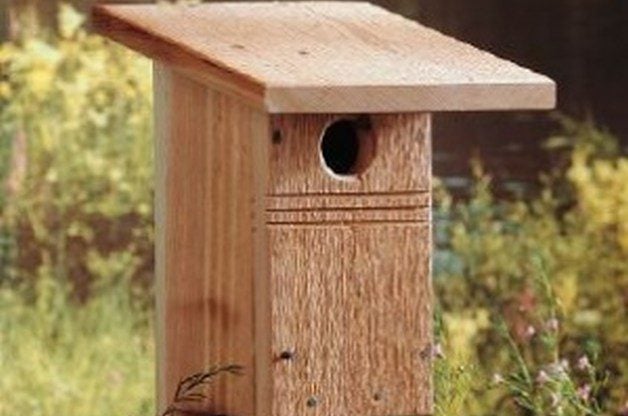
Bluebirds prefer to nest in open areas with low or sparse ground cover. The North American Bluebird Society, which provided the plans, says rural areas, cemeteries, golf courses and parkways with minimal human traffic are good places to mount bluebird boxes. Simply drive a 3/4-inch piece of electrical conduit into the ground and attach the house 5 feet above the ground with conduit straps as shown at right. Attach a predator guard to deter nest raiders.
This bluebird house has a couple of interesting features worth pointing out. It’s assembled with the rough side of the wood facing out so it more closely resembles the birds’ natural nesting sites. And there’s no perch. Notches beneath the entrance hole provide footing for bluebirds, but discourage visits from competing house sparrows and wrens.
The swing-open side is convenient, also. You can check for nests of unwanted birds (since house sparrows and European starlings are not protected by law, simply remove their nests) and have easy access for cleaning out the bluebird’s nesting materials after the young have fledged. You’ll want to do this immediately, since bluebirds often raise as many as three broods in one nesting season.
Best of all, the swing-open side will give you a chance to peek in on the nestlings for whom you’ve provided a sturdy and safe home. The side door is great for monitoring the activity in these bluebird houses.
Bluebird House Specifications
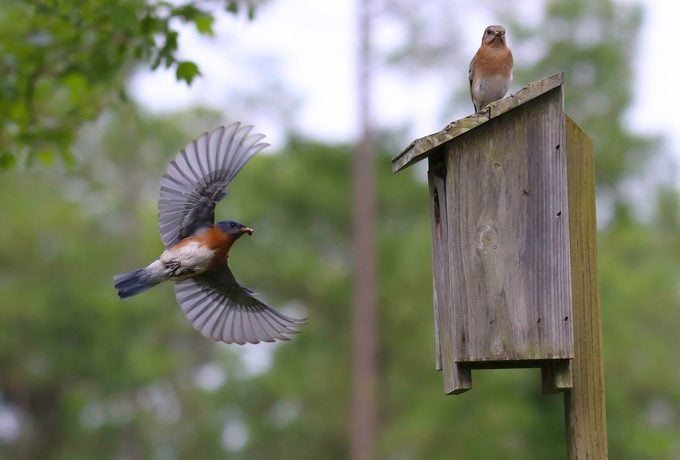
- An entrance hole of 1 9/16 inches will safely entice eastern, mountain or western bluebirds. However, it’s best to look up specific nest box details for your local bluebirds.
- Stick with plain wood boxes offering good ventilation.
- Look for options with sloped roofs that overhang the entrance to keep water out.
- Either buy a nest box with drainage holes on the bottom or drill a few yourself.
- Be sure to select a nest box with easy access for cleaning after a brood has fledged.
Bluebird House Materials
- One 4-foot 1-inch x 6-inch rough cedar board
- One 10-1/2-inch 1-inch x 10-inch rough cedar board
- 2-inch finishing nails
- 1-5/8-inch galvanized deck screws
- 8 feet of 3/4-inch conduit and two straps
- Table saw
- Power drill
Step-by-Step Bluebird House Plans and Instructions
Step 1
Using the full width of a 4-foot 1-inch x 6-inch rough cedar board, cut the pieces as pictured in the board layout below. When making the angled cuts, keep in mind that all the pieces will be assembled rough side out.

Step 2
Drill a 1-1/2-inch entrance hole in the front piece with a spade bit for eastern and western bluebirds. In areas where mountain bluebirds reside, drill the entrance hole 1-9/16 inches. Center the hole about 1-1/2 inches from the top of the board.
Step 3
Starting about 1/2 inch below the entrance hole, make three shallow cuts about 1/4 inch apart on both sides of the front board. On a table saw, set the blade at 1/8 inch deep and use the saw’s miter gauge to cut the notches. Flip the piece over and make identical cuts on the other side. If you want the front board to fit flush with the roof, cut an optional angle along the top edge by tilting the table saw blade 12 degrees.
Step 4
Position the sides flush with the top of the front board. Fasten the right side to the front with two 2-inch finishing nails. Fasten the left side to the front with a 1-5/8-inch deck screw near the top (drill a pilot hole first). Be careful not to over-tighten this screw because it will serve as a hinge for the side door.
Step 5
Cut an optional 12 degree angle along the top edge of the back piece if you want it to meet flush with the roof. Then place the assembled front and sides on top of the back piece, leaving the top of the back board 1/4 inch higher than the sides. The space provides ventilation.
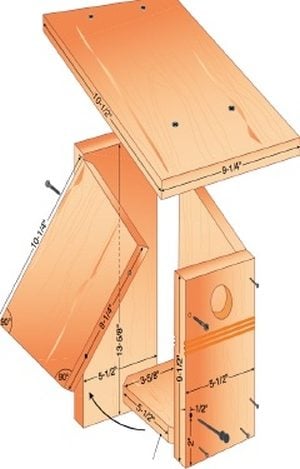
Step 6
Turn the box over and attach the back to the left side of the box (the one with the “hinge”) with a 1-5/8-inch deck screw. Drill a pilot hole first directly opposite the screw on the front (this ensures proper hinge action) and fasten with a screw. Again, don’t make it too tight. Secure the other side to the back with three 2-inch finishing nails.
Step 7
Cut about 1/2 inch off each corner of the floor to provide drainage. Position the floor 1/4 inch up from the bottom of the nest box. (Recessing the floor helps keep the box dry.) Attach the floor with 2-inch finishing nails on the front, back and right side. Do not use nails through the “hinged” left side or you won’t be able to open it.
Step 8
Drill a hole on the hinged side 2 inches up from the bottom and 1/2 inch in from the side. Drill at a slight downward angle, going through the front of the house and into the side. Make the hole large enough for a double-headed nail to slip in and out easily. Insert the nail to hold the side door closed.
Align the roof flush with the back and attach with 1-5/8-inch deck screws (drill pilot holes first).
Step 9
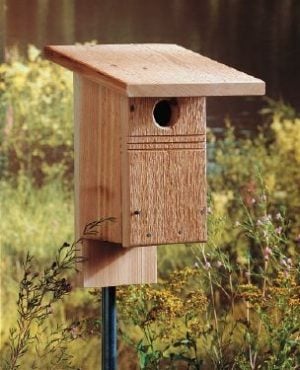
The nest box is ready to mount. Keep the entrance hole about 5 feet above ground.
The Bluebird Society recommends attaching your bluebird box to a smooth round pipe, such as a 3/4-inch electrical conduit, rather than on a tree or fence. Conduit straps attached to the back work well for mounting. For extra protection from predators, put hardware cloth under the box to deter snakes.
Face the bluebird box away from prevailing winds and towards a tree or shrub no more than 100 feet away. This will provide a landing spot for young birds when they first leave the box.
Next, learn how to build a one-board DIY birdhouse.
Why Trust Us
For nearly 30 years, Birds & Blooms, a Trusted Media Brand, has been inspiring readers to have a lifelong love of birding, gardening and nature. We are the #1 bird and garden magazine in North America and a trusted online resource for over 15 million outdoor enthusiasts annually. Our library of thousands of informative articles and how-tos has been written by trusted journalists and fact-checked by bird and garden experts for accuracy. In addition to our staff of experienced gardeners and bird-watchers, we hire individuals who have years of education and hands-on experience with birding, bird feeding, gardening, butterflies, bugs and more. Learn more about Birds & Blooms, our field editor program, and our submission guidelines.
Sources
- North American Bluebird Society
- NestWatch
- Reviewed by Kenn and Kimberly Kaufman, official birding experts for Birds & Blooms

